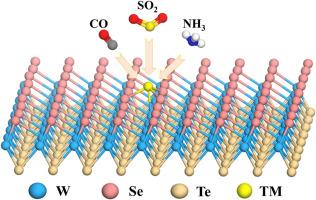Enhanced gas sensing performance of Janus-type WSeTe monolayers: A first-principles study
IF 2.4
4区 物理与天体物理
Q3 PHYSICS, CONDENSED MATTER
引用次数: 0
Abstract
The emerging field of two-dimensional materials shows promise for advanced gas sensing applications. This study employs first-principles DFT calculations to investigate gas sensing performance of Janus WSeTe monolayers modified with Fe, Co, Ni, and Cu. While pristine WSeTe exhibits weak interaction with CO, SO2, and NH3, metal doping significantly enhances adsorption affinity through charge transfer mechanisms. Computational results reveal Cu@WSeTe demonstrates exceptional CO detection capability, while Fe/Ni/Cu-modified samples exhibit strong SO2 sensing performance. Notably, all TM@WSeTe systems maintain effective NH3 detection. These findings establish Janus WSeTe monolayers as promising candidates for next-generation toxic gas sensors through strategic metal functionalization. The optimized charge transfer properties enable selective and sensitive detection across multiple target gases, highlighting their potential in environmental monitoring and safety applications.

janus型WSeTe单层膜增强气敏性能:第一性原理研究
二维材料的新兴领域显示了先进气体传感应用的前景。本研究采用第一性原理DFT计算来研究用Fe、Co、Ni和Cu修饰的Janus WSeTe单层膜的气敏性能。而原始WSeTe与CO、SO2和NH3的相互作用较弱,金属掺杂通过电荷转移机制显著增强了吸附亲和力。计算结果表明Cu@WSeTe具有优异的CO检测能力,而Fe/Ni/ cu改性样品具有较强的SO2检测性能。值得注意的是,所有TM@WSeTe系统都保持有效的NH3检测。这些发现表明,通过战略性金属功能化,Janus WSeTe单层膜有望成为下一代有毒气体传感器的候选材料。优化的电荷转移特性能够对多种目标气体进行选择性和灵敏度检测,突出了其在环境监测和安全应用中的潜力。
本文章由计算机程序翻译,如有差异,请以英文原文为准。
求助全文
约1分钟内获得全文
求助全文
来源期刊

Solid State Communications
物理-物理:凝聚态物理
CiteScore
3.40
自引率
4.80%
发文量
287
审稿时长
51 days
期刊介绍:
Solid State Communications is an international medium for the publication of short communications and original research articles on significant developments in condensed matter science, giving scientists immediate access to important, recently completed work. The journal publishes original experimental and theoretical research on the physical and chemical properties of solids and other condensed systems and also on their preparation. The submission of manuscripts reporting research on the basic physics of materials science and devices, as well as of state-of-the-art microstructures and nanostructures, is encouraged.
A coherent quantitative treatment emphasizing new physics is expected rather than a simple accumulation of experimental data. Consistent with these aims, the short communications should be kept concise and short, usually not longer than six printed pages. The number of figures and tables should also be kept to a minimum. Solid State Communications now also welcomes original research articles without length restrictions.
The Fast-Track section of Solid State Communications is the venue for very rapid publication of short communications on significant developments in condensed matter science. The goal is to offer the broad condensed matter community quick and immediate access to publish recently completed papers in research areas that are rapidly evolving and in which there are developments with great potential impact.
 求助内容:
求助内容: 应助结果提醒方式:
应助结果提醒方式:


